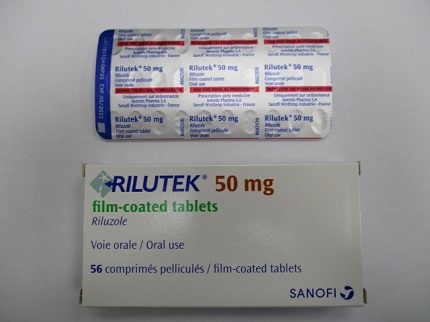Quest for the right Drug

רילוטק RILUTEK (RILUZOLE)
תרופה במרשם
תרופה בסל
נרקוטיקה
ציטוטוקסיקה
צורת מתן:
פומי : PER OS
צורת מינון:
טבליות מצופות פילם : FILM COATED TABLETS
עלון לרופא
מינוניםPosology התוויות
Indications תופעות לוואי
Adverse reactions התוויות נגד
Contraindications אינטראקציות
Interactions מינון יתר
Overdose הריון/הנקה
Pregnancy & Lactation אוכלוסיות מיוחדות
Special populations תכונות פרמקולוגיות
Pharmacological properties מידע רוקחי
Pharmaceutical particulars אזהרת שימוש
Special Warning עלון לרופא
Physicians Leaflet
Adverse reactions : תופעות לוואי
4.8 Undesirable effects Summary of safety profile In phase III clinical studies conducted in ALS patients treated with riluzole, the most commonly reported adverse reactions were asthenia, nausea and abnormal liver function tests. Tabulated summary of adverse reactions Undesirable effects ranked under headings of frequency are listed below, using the following convention: very common (1/10), common (1/100 to <1/10), uncommon (1/1,000 to <1/100), rare (1/10,000 to <1/1,000), very rare (<1/10,000), not known (cannot be estimated from the available data). Very common Common Uncommon Not known Blood and Anaemia Severe lymphatic neutropenia (see system disorders section 4.4) Very common Common Uncommon Not known Immune system Anaphylactoid disorders reaction, angioedema Nervous system Headache, disorders dizziness, oral paraesthesia, somnolence Cardiac Tachycardia disorders Respiratory, Interstitial lung thoracic and disease (see mediastinal section 4.4) disorders Gastrointestinal Nausea Diarrhoea, Pancreatitis disorders abdominal pain, vomiting Skin and Rash subcutaneous tissue disorders Hepato-biliary Abnormal liver Hepatitis disorders function tests General Asthenia Pain disorders and administration site conditions Description of selected adverse reactions Hepato-biliary disorders Increased alanine aminotransferase usually appeared within 3 months after the start of therapy with riluzole; they were usually transient and levels returned to below twice the ULN after 2 to 6 months while treatment was continued. These increases could be associated with jaundice. In patients (n=20) from clinical studies with increases in ALT to more than 5 times the ULN, treatment was discontinued and the levels returned to less than 2 times the ULN within 2 to 4 months in most cases (see section 4.4). Study data indicate that Asian patients may be more susceptible to liver function test abnormalities - 3.2% (194/5995) of Asian patients and 1.8% (100/5641) of Caucasian patients. Reporting of suspected adverse reactions: Reporting suspected adverse reactions after authorisation of the medicinal product is important. It allows continued monitoring of the benefit/risk balance of the medicinal product. Any suspected adverse events should be reported to the Ministry of Health according to the National Regulation by using an online form at https://sideeffects.health.gov.il

פרטי מסגרת הכללה בסל
התרופה תינתן לטיפול בטרשת אמיולוטרופית לטרלית (ALS) ובהתאים לכללים האלה: 1. התחלת הטיפול בתרופה תהיה על פי מרשם של מנהל מחלקה בבית חולים או של מנהל מרפאה שהם רופאים מומחים בנוירולוגיה. 2. ניתן מרשם כאמור, ייעשה המשך הטיפול בה על פי מרשם רגיל של רופא.
מסגרת הכללה בסל
התוויות הכלולות במסגרת הסל
| התוויה | תאריך הכללה | תחום קליני | Class Effect | מצב מחלה |
|---|---|---|---|---|
| התרופה תינתן לטיפול בטרשת אמיולוטרופית לטרלית (ALS) | 09/03/1999 |
שימוש לפי פנקס קופ''ח כללית 1994
לא צוין
תאריך הכללה מקורי בסל
09/03/1999
הגבלות
תרופה מוגבלת לרישום ע'י רופא מומחה או הגבלה אחרת
מידע נוסף
